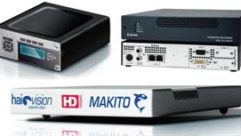

Telemedicine: Better than the Real Thing
During their simulated emergency-room trial, every move the student nurses made was quietly overseen by their instructors, who observed the students via video cameras from one of two monitoring stations.
Every move and comment made by the nursing students in this simulation lab at Xavier University is observed and heard by their instructors via the $108,000 AV system, which also records the sessions so students can review what they did right and wrong.
“>
Every move and comment made by the nursing students in this simulation lab at Xavier University is observed and heard by their instructors via the $108,000 AV system, which also records the sessions so students can review what they did right and wrong.
Credit: courtesy Crestron
CHALLENGE:
Design an audio system that augments a hospital simulation environment that’s confined to a relatively small, loosely partitioned area.
SOLUTION: Using DSP software, enhance audio capabilities of proprietary simulation equipment featuring inadequate speakers; program control software to gate microphones in areas of the room that are not being utilized.
STUDENTS AT THE XAVIER UNIVERSITY’S Department of Nursing are losing Al. Maybe he didn’t receive the proper medication. Or maybe CPR wasn’t administered quickly enough. Whatever the case was, the student nurses frantically work to recover the 60-year-old heart-attack victim’s cratering vitals as his condition deteriorates.
A tragedy? Hardly. More like a learning experience. Al is not a man in serious trouble. He’s human patient simulator — a $50,000 high-tech, life-sized doll who will certainly live to die another day.
Instructors monitor and record nursing students in the patient-simulation lab from these stations, which include a Marshall monitors (top) and Crestron touch panels (bottom).
“>
Instructors monitor and record nursing students in the patient-simulation lab from these stations, which include a Marshall monitors (top) and Crestron touch panels (bottom).
Credit: courtesy Crestron
And the students at the Cincinnati-based Jesuit university aren’t in any real trouble either. Thanks to $108,000 worth of AV equipment that was installed last summer, they were just trained by the most powerful learning tool of all — experience — in an environment that looks, sounds, and feels like a real emergency room.
During their simulated emergency-room trial, every move the student nurses made — including how they interacted with the mock patient’s “family” in a simulated waiting room — was quietly overseen by their instructors, who observed the students via video cameras from one of two monitoring stations.
TRAILING AUDIO
In augmenting the Xavier Department of Nursing’s hospital simulation environment, AV systems integrator Premier Network Solutions had several audio challenges to overcome.
First, each of the “rooms” — whether it be the patient area or the waiting room — are not discrete areas partitioned off by walls. With the students moving about what is essentially an open space with Shure microphones embedded in different areas, Steve Immerman, a Premier project manager, had to design the audio system so that microphones in the areas not currently involved in a simulation would automatically switch off.
“The facility does have sound issues based on the close proximity of each of the areas. So, we have the audio following whatever cameras are selected by the lab technician at the time,” says Immerman, who integrated this capability within the Crestron control software.
Meanwhile, the loudspeaker embedded in the patient simulator’s head presented other challenges, because students couldn’t hear the audio unless they were right up on the device.
By spending several hours toying with the set-up software for the AV systems’ ClearOne XAP 800 DSP processor, however, Immerman and his team were able to maximize the limited sound capabilities of this proprietary device. “We used high-pass and low-pass filters to focus on the desired frequencies as well as working with the gain structure for the audio,” Immerman explains. “We didn’t want to get to the point of disassembling [the simulator’s] head. … By just utilizing the software, we were able to improve the quality of the audio.”
Using the same Crestron CP2E control system that ties together the ceiling-mounted array of six Sony pan-tilt-zoom (PTZ) cameras, these instructors record everything that happens in the simulation room on an Accordent Capture Station. Later, they pour over all this footage with the students and review what the student nurses did right and what they did wrong.
“When I came to Xavier a year and a half ago, I visited several other universities and hospitals to see what they had [in their simulation rooms] and what they did with them,” says Mary Sizemore, director of laboratory and simulation technology for Xavier’s nursing school. “Our room includes the high points of what I saw on my travels.”
Confined to a relatively small floor plan, Xavier’s simulation area encompasses two patient rooms, a nursing station, a waiting room, and a control room. These small, virtual areas are not partitioned by any kind of wall.
Al, the “patient,” features pupils that dilate and constrict in response to light, eyelids that blink more rapidly, and a heart that palpitates if, say, he’s incubated incorrectly.
With the help of a Shure EZO Easyflex microphone embedded in the ceiling of the mock ER, and sensors placed throughout the simulator’s body, Al —who on occasion, assumes other personas, such as a hypertensive pregnant teenager — can even tell the nurses that the shot they’re giving him hurts.
Of course, such sentience is all provided by instructors in the control room, who give voice and reaction to the life-sized doll based on the decisions the students make.
“What I say in the control room comes out of Al’s head,” explains Sizemore, who often uses a Boss VT-1 voice modulator to accurately inflect the appropriate age and gender of the patient being simulated. “It’s like he’s talking to them.”
Point and Click
For more information about the companies and products mentioned in “Even Better Than the Real Thing,” please visit the company Web sites.
Accordent
Boss
ClearOne
Crestron
Marshall Electronics
Shure
Sony
Originally, Sizemore had planned to reconstruct the facility with large windows of two-way glass between the simulation areas and the instructors’ monitoring stations — a move that would have sent the budget way above the $250,000 it ultimately came in at. “Fortunately, the technology was advanced enough so that we didn’t have to rebuild the facility,” Sizemore says.
To design and install an AV system that would include control, camera video, VGA routing, and audio and recording, Sizemore turned to local Cincinnati integrator Premier Network Solutions.
“We had been doing a number of other things for Xavier when this project came up two years ago,” notes Premier’s Steve Immerman, the Crestron-certified programmer who managed the installation.
Having never created an AV system to support such an environment before, Premier had to start from scratch, without a design template. “It’s a unique facility,” explains Immerman, who says Premier had about five months from initial design to implementation. “We really learned more after the project was already sold. It was definitely a process of redesigning and redesigning again until we got it right.”
Equipment List
All the audio products used in the sound installation in the nursing simulation lab at the School of Nursing at Xavier University.
Manufacturer Quantity Model
Crestron 1 CP2E
Crestron 1 QM-MD8x8
Crestron 3 QM-WMC
Crestron 2 QM-RX
Crestron 1 QM-TX
Crestron 1 QM-RMCRX-BA
Crestron 2 QM-MD7X2
Crestron 2 TPMC-17-QM
ClearOne 1 Xap 800
Accordent 2 Capture Stations
Marshall 2 V-R82DP-2C
Marshall 2 V-R44P
Middle Atlantic 1 ERK-1825
Middle Atlantic 1 PD-915R
Key to the system was the ability of instructors to monitor and record students in the simulation area. For that purpose, Premier ceiling-mounted six Sony EVI-D70 cameras throughout the facility. “The cameras are small and white, you really don’t notice them,” Sizemore notes.
“These are switched with a Crestron C2N-IVDS 24×24 video distribution switcher,” Immerman adds. “Each monitoring station has a [Marshall V-R82DP] preview monitor for each of the cameras relevant to the station as well as a confidence monitor for the camera that is being recorded.”
For audio, a ClearOne XAP 800 sound management and distribution platform, which includes eight microphone inputs, a mic mixer, and DSP-based echo and noise cancellation, was installed.
“During simulations, the microphone in the control room allows the lab facilitator to directly communicate with the students through a loudspeaker in the head of the simulator,” Immerman explains. “The students’ audio is also captured using a microphone located near the simulator.”
All voice and camera data is recorded by an Accordent Capture Station, which is a rich media recording appliance. “We can also [record] the patient simulator’s vital signs, as well as the students’ to whatever the students jot down on their tablet PCs,” Immerman notes.
The control system is built around a Crestron CP2E processor, with lab managers utilizing one of two Crestron TPMC-17s as their primary interface.
The system also employs Crestron QuickMedia processors and routers so that its complex VGA routing can occur over a more-simplified Cat-5 wire configuration. “We utilize a QM MD 8×8 switch to provide the matrix switch capability,” Immerman says. “Using this technology, we were able to easily distribute the signals throughout the facility while also providing additional expansion capabilities for the future.”
“When the students are in the room at first, they have no idea they’re being taped, because the cameras and the microphones are hidden so effectively” Sizemore adds. “This is a safe place to learn. This is where they get to play nurse.”
Daniel Frankel is a Los Angeles–based freelance writer. He can be reached at [email protected].










